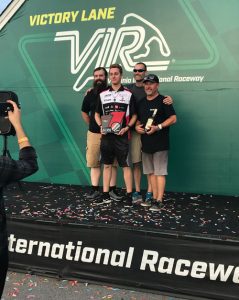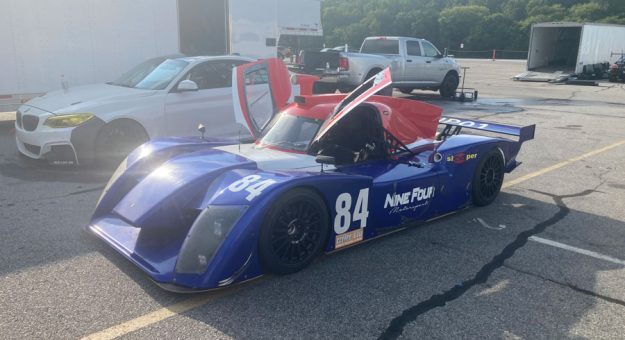MOORESVILLE, N.C. — Labor Day Weekend gave me a chance to race for a new team in an endurance race at beautiful Virginia Int’l Raceway.
It was a two-day, eight-hour World Racing League endurance race on Saturday and Sunday with qualifying on Friday.
I made my debut with Nine Four Motorsports in the NP01 prototype. Although I had never driven with Nine Four before, the team had already won a race this season at Road America despite the fact that on average they were eight seconds a lap off the pace of the fastest cars in the GTU Class.
Podiums in the GTU class are usually determined by mechanical issues and strategy instead of pure pace.
That was the case Labor Day weekend.
After getting acquainted with my teammates for the weekend, as well as my crew chief and team owner, our main focus on Friday was to maximize our laps.
Personally, I only needed to become familiarized with the track, as I had already driven three different NP01s. I was quite familiar with the car’s capabilities and characteristics, but I was not familiar with VIR. I did some simulator work at VIR beforehand, but there were 70 other cars and drivers that were very familiar with the track.
Friday’s practice and qualifying sessions allowed us to tune the car’s setup to “medium” so that it suited all the drivers. In qualifications, I was the most familiar with the NP01, so I went out first. The balance of the car felt good.
Later in the afternoon, I got back in the car and was determined to run our fastest qualifying lap while testing the setup adjustment that was made to help balance the car. The lap times were better, but it felt like a less than optimal setup in four corners of the track.

We qualified third in our class for race one. The two NP01 entries qualified ahead of us were both Stratus cars — a team that has been running NP01 since 2020.
The cars that qualified behind us were newer teams with very little experience. I could tell that, pace-wise, the best we could hope for was third on the grid because the Stratus cars were just too fast and the other cars too slow.
But remember, pace doesn’t determine podiums, mechanicals and strategy do.
By Saturday evening, we determined the driver lineup for the day. I lobbied for the fastest guys to go first and last in the rotation. The beginning of the race has the most cars, traffic and potentially tricky situations that need to be navigated quickly and safely.
As for last, the end of the race has the least number of cars because of incidents and mechanical failures. I offered to go first because I felt comfortable.
I played it safe for the first couple of laps, while a lot of action went down in front of me. I dropped back to fourth in class, but over the next few laps I worked up to second in class.
An early caution came out and the class leader pitted early. That put us first because we stayed out.
At the end of my two-hour stint, which was riddled with cautions, I handed over the car to one of my teammates in first place. Things were looking pretty good for a podium finish at the very least.
Over the course of the race, we dropped to third as the Stratus cars put down consistent faster times than our car. Fortunately, we were able to avoid any mechanical issues, but our strategy didn’t play out perfectly with the late-race cautions.
That is why we didn’t come out on top. But we did finish third.
Sunday’s race was even crazier than Saturday’s. It had just as many cautions but one fewer red flag.
This time we decided to switch up the order so that I would go last in the car. This would, hopefully, give me a good opportunity to run with as little traffic as possible and maximize our pace.
We started third, but mechanical issues early forced us back to our pit where we replaced the throttle body. When we went back on track, we were many laps down in last place. We were able to slowly make up laps because the competition also had issues.
With three hours to go, I got in the car. The plan was to finish the race in one piece.
When I got in, we were five laps down to the third-place car in our class. Rain had already begun to fall on the track, so I went out as the track slowly began to lose more and more grip as the rain fell harder.
I was consistently running lap times faster than the competition in the mixed conditions, but cautions made it hard to recover the laps we were down. We were still four laps down from getting on the podium when a red flag came out stopping the race for one hour.
This made our dire circumstances worse because it meant less time for me to make up the laps we were down. However, by the time the red flag was lifted, the track had dried a good amount and I was able to run more aggressively.
With four laps to go in the race, the car we were racing against for third broke down and was stuck on the track unable to move.
It came down to the final lap when I finally passed the car to take over third. The drama wasn’t done yet though because it turned out that both Stratus cars that finished ahead of us were disqualified during post-race tech for being slightly over the allowed horsepower.
That gave us the win for race two, which made the weekend even better.
I got a lot of solid seat time and experience at a track I had never been to before and slowly got faster and faster over the course of the weekend. I was happy about my performance and the results reflected the hard work of the team, which is always a plus.
Now, I can’t wait for next weekend where I’ll be running at another track that I’ve never been to before, Watkins Glen (N.Y.) Int’l.
